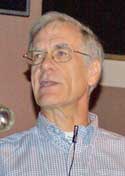
Multi-breed evaluation is not new, but what we're going to do with it is, says John Pollak of Cornell University.
Multi-breed Genetic Evaluation for Beef Cattle
Efforts attempt to create integrated system to gather input from all segments of the industry.
 Multi-breed evaluation is not new, but what we're going to do with it is, says John Pollak of Cornell University. |